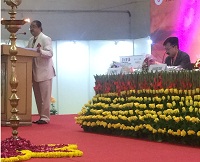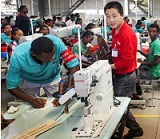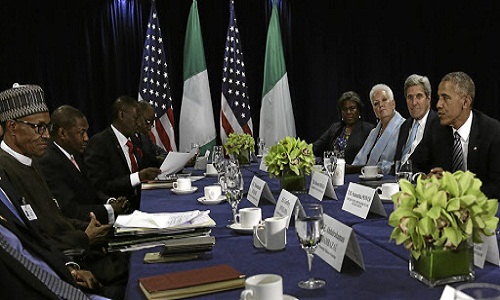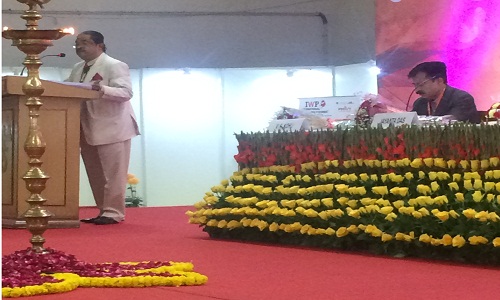FW
"The 18th edition of Tex-Styles exhibition opened its doors today in the capital today. ITPO’s executive director Rajneesh inaugurated the fair. Also present at the inauguration were Yash Mudgil, Additional Resident Commissioner, J&K, Purshottam K Vanga, Chairman, Powerloom Development Council, Prem Singh, DGM, ITPO, top industry stakeholders among others."

The 18th edition of Tex-Styles exhibition opened its doors today in the capital today. ITPO’s executive director Rajneesh inaugurated the fair. Also present at the inauguration were Yash Mudgil, Additional Resident Commissioner, J&K, Purshottam K Vanga, Chairman, Powerloom Development Council, Prem Singh, DGM, ITPO, top industry stakeholders among others.
Showcasing the best in Indian textiles
In his welcome speech Jayant Das, GM, ITPO said the aim of Tex-Styles is to promote useful business convergence and awareness among manufacturers and buyers. “This is a premier B2B event showcasing the complete supply chain of the textile industry. Tex-Styles India also intends to empower small and medium enterprises which are the backbone of the Indian textile sector due to their inherent ability to promote exports and generate employment opportunities.”
He said, this year the fair also reflects the strong determination and commitment of the textile industry to showcase the best the sector despite several odds. “The fair is an occasion to showcase India’s world famed “textile brand” under one roof. Since its inception in 1995, Tex-Styles India Fair has emerged as an ideal forum for presenting the multi-faceted splendor of the Indian textile industry and established itself as the leading fair of its kind in South East Asia.”
Das said “We are confident that the textile sector will get further boost through the policy initiatives such as the GST. Empowering the industry, the government has also geared up to tie-up soon with the States and roll out a new scheme called ‘TIES’ (Trade Infrastructure for Export Scheme) to boost export infrastructure in alignment with the National Foreign Trade Policy as well as enhancing Central Agencies to set up common facilities for testing, certification trackback, packaging, labelling and storage.” He goes on to say exports of textiles and apparel have achieved a growth rate of 14 per cent in rupee terms and 7.5 per cent in dollar terms during the last three financial years. “Tex-Styles India also intends to empower the SME sector which is the backbone of Indian textile economy due to its inherent inherent ability to promote exports and generate employment opportunities.”
This is the only textile show in India which provides users a one-stop platform for purchase of every conceivable textile product produced by India i.e. furnishings, floor coverings, fabrics, garments, accessories etc. While a host of apex textile handloom and garment bodies like Department of Handloom Development, Govt. of Jammu & Kashmir, Khadi & Village Industries Board, Handloom Export Promotion, Chennai, Indian Silk Promotion council, New Delhi among others are participating Jammu and Kashmir is participating in as a ‘Partner State’ for the first time. Then there are theme pavilions, trend forums, fashion shows, fabric folios will be meaningful in terms of highlighting the new trends, season’s forecasts and innovative concept for textile industry.
The event also features an intensive strength of the tradition and updated textile industry which has a vast network of production centres, as well as millions of SMEs homes of its handlooms artisans all across the country. Markets and better integrating with major regions, thereby increasing the demand for India’s products and contributing to the ‘Make in India’ initiative; and to provide a mechanism for regular appraisal in order to rationalize imports and reduce the trade imbalance.
The fair is being held at Hall No. 11, Pragati Maidan from February 21 to 24, 2017. Covering an area of more than 5,000 sq. mt., Tex Style India features a wide range of products and services – fibers and yarns, cotton, wool, jute, synthetics and various blends, pure blended silk and wool, linen and its finer counts in cotton, blends in synthetics, hand wovens, denims, furnishings and made-ups, shawls, tassels, laces, threads, jackets, pants, skirts, blouses, shirts, cut and sewn garments etc.
Tex-Styles, New Delhi is currently on offers a stunning range of exhibits. The technical textile range covers nets, surgical, medical and sanitary textiles, technical and safety apparel, car seat covers, woven sacks, sportswear, upholstery, labels and laces, belts, ropes and hoses, nylon tyre cord fabric, geo-textiles etc.
Among apparel for men, women and children are outer wear and jackets, pants, skirts, one-piece dresses, blouses, shirts, tunics, cut and sewn garments. Textile gifts range from home decorative to fashion accessories. Trims and accessories like shawls, tussels, laces, threads and other embellishments enhance the look and feel of modern apparel and furnishings.
There is a range of textile process machinery for cloth finishing, knitting, fabric seaming, crochet, lace making, label making, quilting, textile finishing and sourcing, textile spinning, winding, edge control devices, thread winding, tufting, weaving and zipper making.
Then there is a display of machinery for applique scaling, attaching, cloth measuring, cloth cutting, embroidery, garments, industrial sewing, laundry dryers, monogramming, textile bleaching, textile folding and textile trimmers. Looms include gripper loom, rapier loom, water jet loom, airjet loom and looms with shuttles. Support services include CAD/CAM systems, color and trend forecasts, trade publications and support services for the textile and furnishing industry.
Shanghai Tex will be held in China from November 25 to 28, 2019. This is not just an annual academic exchange platform gathering researchers, engineers and professionals, it is also an international cross-industry event. It is expected to attract over 1,200 exhibitors showcasing top-notch textile machines, cross-border technologies and applications, helping the enterprises to expand their businesses and drive towards AI in manufacturing. The fair is committed to helping designers and manufacturers break away from traditional production, with the aim of meeting future demand and tap into new markets. Conferences such as textiles during the different stages of a woman’s life, the digital printing arena, wearable technology, and the latest AI developments and applications in the textile and fashion industry will be organized during the fair, providing a platform for exchanging views on the latest market trends.
There will be zones dedicated to spinning, manmade fiber and tech textile machinery, weaving machinery, knitting and hosiery machinery, printing, dyeing and finishing machinery, digital printing machinery, spare parts and accessories for textile machinery, dyestuff and textile chemicals, and a zone for sustainable, eco-friendly technology and recyclable materials. The zones are for optimizing the textile and fashion supply chain.
"African Growth and Opportunity Act (AGOA), signed into law by the Clinton administration in 2000, was designed to provide African manufacturers tariff-free access to the US market to bolster trade. Indeed the legislation proved a dynamic employment vehicle in signatory countries, creating as many as 350,000 direct jobs by removing tariffs on some 6,500 products including vehicles, garments and metalwork. The Obama administration signed a 10-year extension to the Act in a move welcomed by African governments and manufacturing associations."

African Growth and Opportunity Act (AGOA), signed into law by the Clinton administration in 2000, was designed to provide African manufacturers tariff-free access to the US market to bolster trade. Indeed the legislation proved a dynamic employment vehicle in signatory countries, creating as many as 350,000 direct jobs by removing tariffs on some 6,500 products including vehicles, garments and metalwork. The Obama administration signed a 10-year extension to the Act in a move welcomed by African governments and manufacturing associations.

Witney Schneidman, senior international advisor for Africa at law firm Covington & Burling, who was involved in the passage of the Act, says it doesn’t matter wherecapital comes from as long as jobs are being created and labour conditions are good, and people and governments benefit. Whether it’s a Chinese, Indian, or Turkish company is not the prime consideration. Yet for its critics, AGOA has had a far more malevolent effect, allowing Chinese and Taiwanese firms to colonise African manufacturing space and curtail indigenous businesses in a cynical bid to access the lucrative US market. With Donald Trump’s presidency dedicated to recasting trading relations – and keen to propagate the idea that China is taking advantage of the US – the debate over who benefits from AGOA could play a key role in US–Africa relations in the years ahead.
The reality check
In 2012, three researchers at the University of Oxford’s Centre for the Study of African Economies, Lorenzo Rotunno, Pierre-Louis Vézina and Zheng Wang, delivered a paper investigating whether Chinese manufacturers were using Africa as a trade corridor to access the US market. They discovered that a combination of restrictive US quotas on Chinese apparel imports and the preferential treatment handed to African manufacturers gave Chinese firms an incentive to route their trade through the continent, even while providing very little work to African employees.
There is some statistical evidence that AGOA has allowed Chinese businesses to use African countries as a trade corridor to reach the US, informs Vézina. This was possible thanks to the absence of rules of origin, meaning that AGOA countries were allowed to source as much garment as they wished from China and re-export to the US. In the end, it was concluded that African involvement was limited to little more than final assembly of almost finished products.
By 2013, according to Tang Xiaoyang, a professor at Tsinghua University, Chinese investment in southern Africa’s apparel sector was at a third of peak levels, the result of the collapse of the MFA, rising labour costs, a skills deficit, and the cancellation of incentives by African governments. Low-cost southeast Asian firms stepped into the breach – a 2016 report from the Office of the US Trade Representative found that while exports from Africa to the US had increased from some $600m in 1999 to almost $1bn in 2015, exports from Vietnam increased over the same period from virtually zero to $10.7bn.
Advantage China
Helen Hai, chief executive of the Made in Africa Initiative, a co-founder of C&H Garments, says it is foreign bulk buyers, rather than African or Chinese manufacturers, that benefit the most from the tariff reductions of AGOA. Rather than taking advantage of their African hosts, committed Chinese firms are bringing manufacturing expertise that the continent previously lacked.
It is this continuing knowledge deficit, rather than an overbearing Chinese presence, which is preventing Africans from accessing AGOA privileges, she argues.
The reason China is able to have scalable manufacturing skills is because they created a cluster this gives economies of scale. If blue-collar wages continue to rise in China, analysts believe Chinese manufacturers will look to Africa as a source of affordable labour.
While critics and defenders of AGOA appear deadlocked over the issue of Chinese influence, election of Donald Trump has upended all assumptions about the future of the Act and wider US trade policy in Africa. Schneidman suggests adding clauses to AGOA to limit overbearing Chinese influence – similar to those introduced by the US Millennium Challenge Corporation limiting Chinese involvement in US-funded infrastructure projects – could resolve criticism. Trump’s perception of China is just as important as the reality. Reform, rather than repeal, may be required if Africans – including those in Chinese factories – are to continue seeing the benefits of AGOA.
Bangladesh’s garment exporters are feeling the effects of Brexit. Shopping centers in the UK are threatening to squeeze suppliers out of their already thin profit margins. UK retailers are themselves in trouble. With the pound plunging a drastic 16 per cent post-Brexit, this has driven up import costs for retailers in the UK. In most cases, the cost is usually passed on to the customer, but high street brands are reluctant to do this, and instead are pressuring suppliers to lower prices instead.
So, British retailers are adopting the strategy of buying from Bangladesh’s manufacturers at lower prices. As their cost of business has risen with the devaluation of the British pound, they have focused on buying more from Bangladesh but at lower prices. However, Bangladesh is worrying about more than just a weak currency. It is also concerned about what form of tariff regime the UK will implement once it leaves the European Union.
This could have implications on the preference many European countries have for the South Asian nation, which in turn would affect its gross domestic product. With the uncertainty the Brexit vote brings, it may lead to temporary suspension of the duty-free market access for all products for Bangladesh exporters.
The failure of American Apparel have nothing to do with American manufacturing, opine a few experts. Like lots of retailers, it expanded too fast, going from one store in 2003 to 281 stores from Brazil to Israel in 2009. It relied on expensive borrowing. When the company went public a decade ago, it warned investors of the potential consequences of significant indebtedness.
American Apparel went from being a small, modestly profitable company in 2003 to a bigger, less profitable company in 2009. Interest costs ate away at its margin for error. And now American Apparel is closing shop. Despite the company’s outlandish offerings — metallic shorts — its main product was basic high quality wear: T-shirts, hoodies and underwear, made of good cotton and cut and stitched well.
The bad news, though, is that American Apparel was hobbled in part because the US doesn’t support manufacturing. Even operating in Los Angeles, and paying well above minimum wage with benefits, it had trouble cobbling together a workforce to cut and sew without running into immigration problems. In 2009, it fired 1,500 workers after a federal inspection.
London is ready to host Texfusion on March 28 and 29, 2017. This trade fair caters to international fashion fabrics and accessories, home textiles, functional fabrics and garment manufacturers. Fashion fabrics will cover Lycra, silk, prints, synthetics, wool, jacquard, cotton and blends, denim, eco friendly fabrics, embroidery and lace, fake fur, zips, knitted fabrics and trims. There will be functional and sportswear linen, active wear, technical fabrics, waterproof, fire resistant, medical fabrics. Home textiles will cover fabrics for duvet covers, sheets, blankets, carpets, towels, kitchen wear. About 140 exhibitors are expected to attend this edition.
The event will provide manufacturers and their agents the opportunity to showcase their products to the most influential buyers and designers on the UK fashion scene.
The show will present a carefully-selected group of high-quality international companies including the finest fabrics and accessories manufacturers. In November 2015 exhibitors came from eight countries. The most represented were China, India, South Korea, Hong Kong and Pakistan.
The fair offers a professional and friendly atmosphere where visitors have the opportunity to source from the most important manufacturers in Asia showing a wide selection of products and demonstrating their competence and experience in both design and production capability.
The Khadi & Village Industries Commission (KVIC) has got orders worth crores from hospitals, research institutions, railways and companies. The orders are for silk jackets, bed sheets, dressing towels, surgical gowns, kurta pajamas, doctor's coats, soaps, hand sanitizers, khadi phenyl and herbal shampoo.
Last year, the sale of khadi products was at Rs 1,510 crores and is projected to grow 35 per cent in the current financial year. Sales have boomed over the last few years. KVIC is also setting up export cells to promote overseas sales of the products, which have a good demand in countries like the US and UK. A beginning will be made with direct exports. The aim is to make khadi an international brand.
KVIC is taking several initiatives to increase the sale of khadi, which today stands under one per cent among total textile sales in the country. For 2016-17, KVIC expects to achieve a turnover between Rs 1900 crores to Rs 2000 crores. The target is to achieve Rs 5000 crores in two years.
Five khadi villages will be set up in every state to make rural populations self reliant and prevent their migration into cities. Interested villagers will be given spinning wheels, looms and other equipments required to set up small scale industries such as candles, incense sticks, honeybee cultivation, bakeries etc.
Jharkhand wants investors for the textile, apparel and footwear sectors as these have good growth potential. As per chief minister T Raghubar Das these sectors are the second largest employers in Jharkhand after agriculture. By products of textile, apparel and footwear are used for making cosmetics, biomedical products and fertilizers. These not only fetch revenue but also generate large scale employment.
Jharkhand’s tussar production increased to 3,238 metric tons in 2016-19 from 143 metric tons in 2007-08. The tassar culture employs 1.80 lakh farmers and 30,000 weavers in the state. The state is planning to construct a textile park. It is also interested in starting a footwear design development institute.
Orient Craft opened in 1972 with merely four people and an investment of Rs 15,000. Now, over 32,000 people are working under the company. The company will invest Rs 3,000 crores and open six skill development centers. Orient Craft will train rural youths and give them employment. In the beginning, migration- affected districts will be taken up for training local youths.
Adesh Gupta, CEO of Liberty Shoes Limited points out, India currently produces 125 crores shoes. Additional capacity of 400 crores will require in next 10 years. Shahi Exports has units in nine states and will soon open a unit in Jharkhand as well.
Italy is losing its iconic brands to foreign, usually French, groups. It is becoming increasingly hard to create a luxury conglomerate in Italy. And companies have to think hard and strategies. Giorgio Armani has created the Giorgio Armani Foundation. Its heirs, three nieces and nephews, are already on the board of directors of the company.
OTB (Only the Brave) controls Diesel and a portfolio of brands including Marni, Maison Margiela, Viktor & Rolf and Paula Cademartori. The founder is already thinking of the future, of his children, and how to ensure a smooth transition in management, and one of the options under consideration is a possible public listing sometime over the next few years.
Similarly Prada opted for a public listing on the Hong Kong stock exchange in 2011. Versace sold a 20 per cent stake to the US fund Blackstone in 2014. Zegna redistributed the ownership stakes among the grandchildren, heirs to the company, in 2014.
The fact remains that these are businesses with broad appeal, to private equity funds and to international investment firms. They are courted by international stock markets. There's no lack of options. The main thing for these companies is to remain attractive by continuing to show steady growth.













